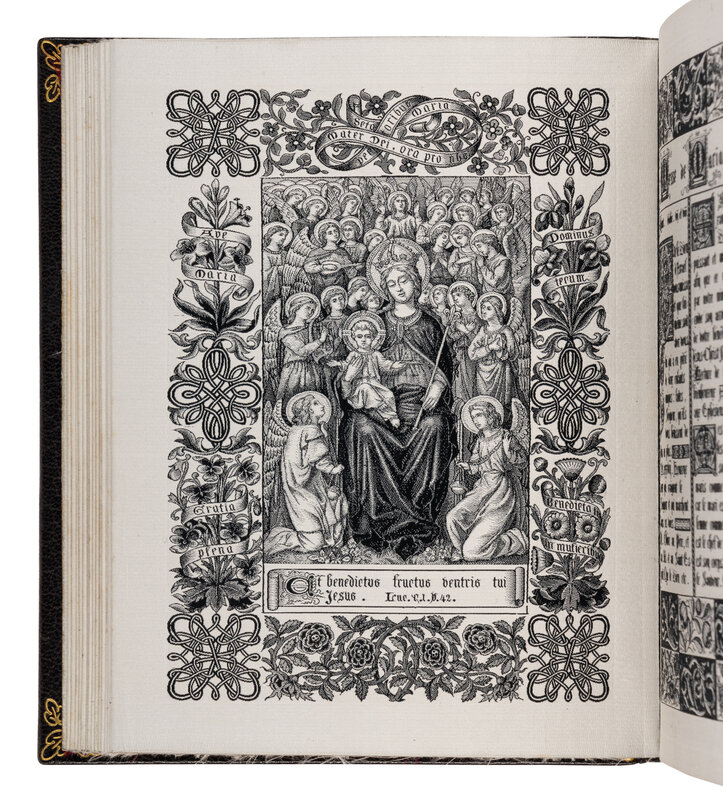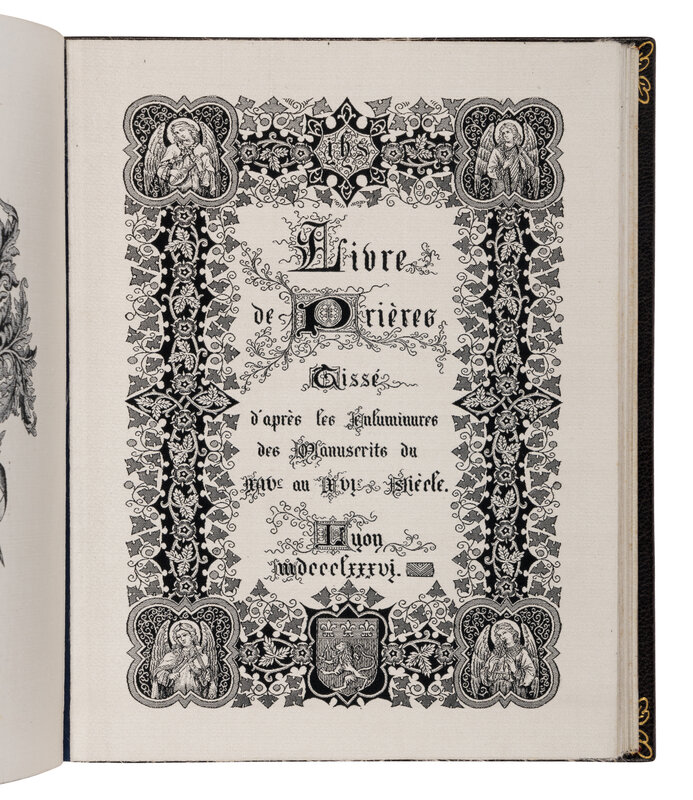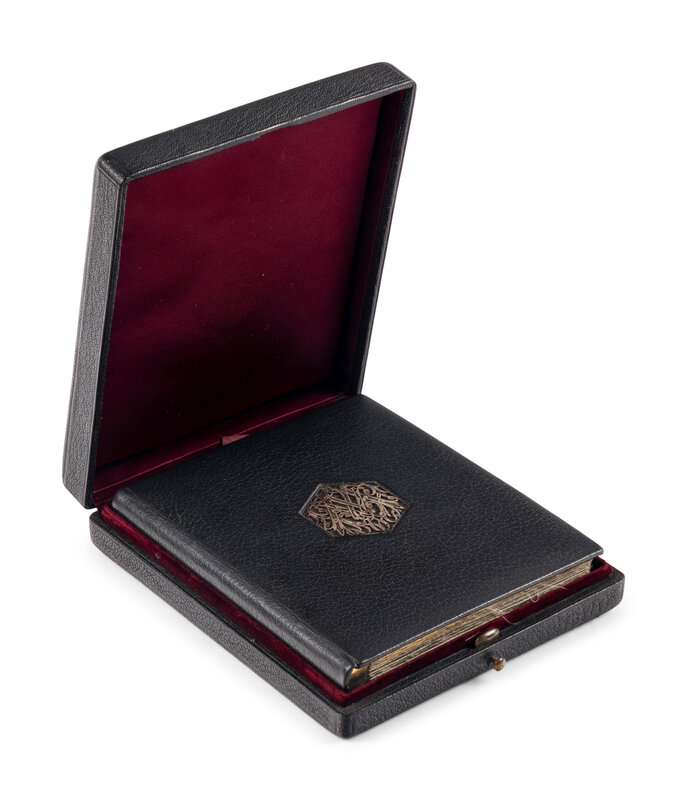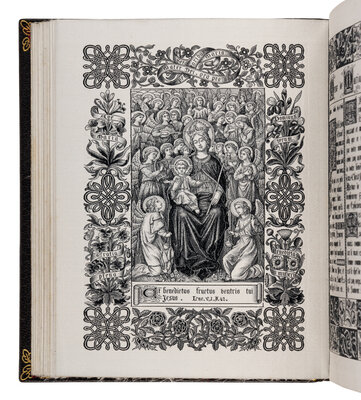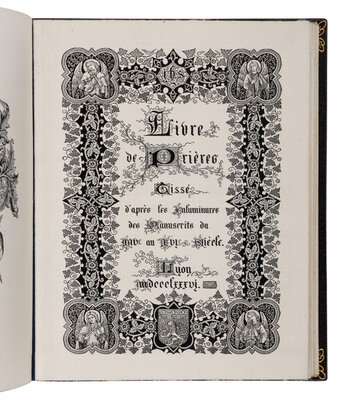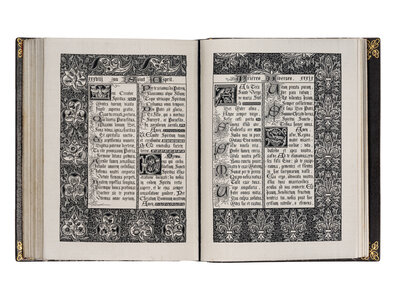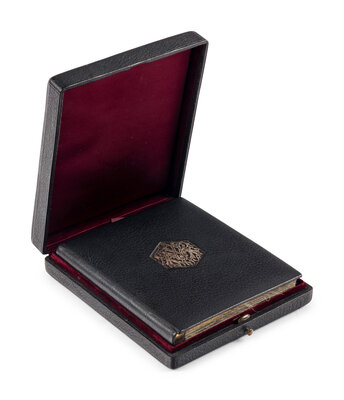Condition Report
Contact Information
Lot 68
WOVEN PRAYERBOOK FROM THE PARIS WORLD’S FAIR R.P.J. Hervier, designer, J. A. Henry, fabricator, Livre de Prières tissé d’après les enluminures des manuscrits du XIVe au XVIe siècle, in Latin & French, illustr. book woven in silk [Lyons, 8 Sept.1887]"
Sale 2033 - Western Manuscripts and Miniatures
Jun 27, 2024
10:00AM CT
Live / Chicago
Own a similar item?
Estimate
$10,000 -
15,000
Price Realized
$15,240
Sold prices are inclusive of Buyer’s Premium
Lot Description
WOVEN PRAYERBOOK FROM THE WORLD’S FAIR IN PARIS
R.P.J. Hervier, designer, J. A. Henry, fabricator, A. Roux, editor
Livre de Prières tissé d’après les enluminures des manuscrits du XIVe au XVIe siècle [Book of Prayers woven after illuminations in manuscripts of the fourteenth and fifteenth century], in Latin and French, illustrated book woven in silk [Lyons, dated 8 September 1887]
R.P.J. Hervier, designer, J. A. Henry, fabricator, A. Roux, editor
Livre de Prières tissé d’après les enluminures des manuscrits du XIVe au XVIe siècle [Book of Prayers woven after illuminations in manuscripts of the fourteenth and fifteenth century], in Latin and French, illustrated book woven in silk [Lyons, dated 8 September 1887]
Considered an antecedent to the computer, this Prayerbook woven with the Jacquard loom programmed with 100,000+ punch cards shared centerstage with Eiffel’s tower at the Paris world’s fair.
168 x 135 mm. ii + 25 + ii silk pages, woven entirely in silver-gray and black silk, paginated in Roman numerals, 1-43, text in two columns of 23 lines (written space: 101 x 82 mm), decorated initials and borders in a variety of styles at every page, one historiated initial, one-half page miniature, two large miniature, and one full-page miniature (in very good condition). Bound in a full black morocco binding signed on the front pastedown by Marius Michel (1846-1925), openwork metal monogram “MV” inlaid in the center of the front cover, fore-edges gilt, linings in red moiré silk, accompanied with a black leather box lined with red moiré silk (silver piece slightly oxidized, else in excellent condition).
The woven Prayer Book contains prayers for morning and night, followed by others for special Masses, including marriage and communion. Every page is richly decorated with ornate borders in the style of illuminated manuscripts from the fourteenth to sixteenth centuries, including the title page with four angels playing musical instruments and the coat of arms of the city of Lyon.
The silk pages were created on a Jacquard loom, a partly automated weaving machine, involving over one hundred thousand punch cards and millions of small manipulations by a skilled weaver. It reportedly took two years and close to fifty trials before a full book was successfully completed. Achieving the pixel-like precision of its text and illustrations required the pages to be woven with four hundred threads per inch, with each black silk thread of the weft (running vertically to the page) passing under the grayish-silver threads of the warp (horizontal to the page). The information for the designs and text was encoded in patterns on punch cards joined together in long chains and fed into the machine perched atop the loom. These punch cards determined the precise movements of mechanized hooks that lifted individual threads, under which the worker shuttled back and forth the black thread. The Jacquard loom assumed the most detail-oriented portion of the process, previously done by a second worker. Historians often point to the woven Prayer Book as one of the most complex and unusual objects produced on a Jacquard loom.
It is difficult to determine how many copies of the Livre de prières tissé were fabricated and how many are extant, since there is no census of the edition. This is in part because it falls between the cracks of traditional cataloguing, because the book is technically neither a printed book nor a manuscript. In addition to a copy in the Walters Art Museum, Baltimore (Randall 1981), there are copies in the following North American institutions: the Newberry Library, Chicago; University of Chicago Special Collections; Denison Library, Scripps College; the Cincinnati Historical Society; the University of Delaware; the College of Saint Catherina, Saint Paul, Minnesota; Watson Library, the Metropolitan Museum of Art, New York; the Morgan Library and Museum, New York; the Rauner Library, Dartmouth College (see also Randall 1981, n. 30, and Laird 2001, no. 63, p. 131, for earlier lists of copies in North America and abroad).
Text
p. {1}, Half-title page, “Livre de Prières”; p. {2}, Escutcheon woven with interlaced initials “MM”; p. {3}, Title-page, “Livre de Prières Tissé d’après les enluminures des manuscrits du XIVe au XVIe siècle. Lyon mdccclxxxvi.”; p. {4}, Official sanction of the content of the volume, dated September 8, 1886, with the name of Cardinal Louis-Marie Claverot, archbishop of Lyon and Vienne; p. {5}, “Les Prières du Matin et du Soir”; pp. 1-4, “Prières du Matin”; pp. 5-10, “Prières du Soir”; pp. 11-24, “Le saint Sacrifice de la Messe”; pp. 25-32, “La Messe de Mariage”; pp. 33-43, Prayers, for Communion (p. 33), to the Sacrament (p. 36), to the Holy Spirit (p. 38), to the Holy Virgin (p. 39), and diverse prayers (p. 42); p. [44], “Table des Matières”.
Illustration
The woven Prayer Book also exemplifies nineteenth-century attitudes toward the illuminated manuscript. Through facsimile editions of medieval manuscripts, Catholic devotional publishing sought to teach catechism to children and to promote “good taste” through manuscript illumination. Parisian publishers held a near-exclusive on the production of the gift book, that is, books for the Mass, “livres de raison,” and marriage books, churned out in large editions, but also sometimes written and illuminated entirely by hand in neo-Gothic style. These facsimiles and the related neo-Gothic manuscripts went a long way toward forming a basis for the re-appreciation of medieval manuscript illumination on the eve of modern times, and the Livre de prières tissé figures large in that history of recovery. In some ways it is an elegant and luxurious, though unorthodox, version of the nineteenth-century gift book, entirely in keeping with the taste of the times (Hindman et al, 2001, esp. pp. 132-143). Comparing the Lyon imprint to gift books, Harthan declared it to be the “final exaltation of the medieval Book of Hours” (Harthan, 1977, p. 174).
The subjects of the half, large, and full-page illustrations are: p. {6}, Nativity (full-page), after paintings by Fra Angelico; p. 11, Elevation of the Host (historiated initial ‘M’); p. 12, Crucifixion (full-page), perhaps derived from a painting attributed to Fra Bartolomeo; p. 26, Virgin and Child surrounded by Angels (full-page); p. 33, Christ with the Virgin and St. John the Baptist (half-page), after the fresco of the Disputation of the Holy Sacrament by Raphael in the Stanza della Segnatura, Vatican City. There are also many reproductions from medieval manuscripts identified by Randall.
LITERATURE
Further literature, see Lilian M.C. Randall, “A Nineteenth-Century ‘Medieval’ Prayerbook Woven in Lyon,” in Art, The Ape of Nature: Studies in Honor of H. W. Janson. New York, 1981, pp. 651-668; Sandra Hindman, et al. Manuscript Illumination in the Modern Age: Recovery and Reconstruction, Evanston, 2001; Michael Laird, “Livre de prières tissé,” in The World from Here: Treasures of the Great Libraries of Los Angeles, Los Angeles, 2001, no. 63; Matthew J. Westerby, The Woven Prayer Book. Cocoon to Codex, Les Enluminures, 2019.
Freeman’s | Hindman thank Senior Consultant Sandra Hindman and Elliott Adam for their assistance in preparing this sale.
